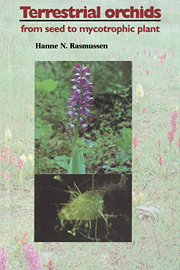Book contents
- Frontmatter
- Contents
- Acknowledgements
- Introduction
- 1 Properties of ‘dust’ seeds
- 2 Seed development
- 3 Seed survival
- 4 Requirements for germination
- 5 Fungi
- 6 Germination processes
- 7 Underground organs
- 8 Orchid mycorrhiza
- 9 Abiotic factors in growth and development
- 10 Life history and phenology
- 11 Propagation
- 12 Effects of orchid mycorrhiza
- 13 Descriptions of genera
- Appendix A Nutrient substrates mentioned in the text
- Appendix B Names and synonyms
- References
- Index
13 - Descriptions of genera
Published online by Cambridge University Press: 13 October 2009
- Frontmatter
- Contents
- Acknowledgements
- Introduction
- 1 Properties of ‘dust’ seeds
- 2 Seed development
- 3 Seed survival
- 4 Requirements for germination
- 5 Fungi
- 6 Germination processes
- 7 Underground organs
- 8 Orchid mycorrhiza
- 9 Abiotic factors in growth and development
- 10 Life history and phenology
- 11 Propagation
- 12 Effects of orchid mycorrhiza
- 13 Descriptions of genera
- Appendix A Nutrient substrates mentioned in the text
- Appendix B Names and synonyms
- References
- Index
Summary
Cypripedium
A circumboreal genus, Cypripedium occurs in bogs, swamps and woodland, especially in forest margins and clearings, usually not in deep shade. C. calceolus is virtually confined to calcareous soils, the topsoil being characteristically friable with a high humus content (Fuchs & Ziegenspeck, 1926a). C. candidum grows in black humus saturated with lime, the soil having a pH of 7.4 (Stoutamire, 1990). A stand of C. reginae in Canada was found growing in soil with about 20% more calcium than the average for the region (Harvais, 1980). Although most of the species thus prefer a neutral or alkaline substrate (Wherry, 1918; Curtis, 1943), C. acaule grows in acid soil (pH 3.5–5.4: Wherry, 1918; Curtis, 1943; Stoutamire, 1963).
In all species the adult plants have a horizontal rhizome and well-developed, dark green foliage leaves, and maintain this foliage from spring to autumn. They overwinter below ground. The vegetative period before flowering is assumed to be long: up to 10 years or more in American species (Curtis, 1943) and 6–10 years in C. calceolus (Kober, 1972; Fast, 1985).
In C. arietinum, C. candidum and C. calceolus var.pubescens the tips of 2 to 3-year-old roots may form buds as a means of vegetative propagation (Curtis, 1943).
Life history
C. calceolus presumably germinates in spring (Fuchs & Ziegenspeck, 1926a), although Irmisch (1853) observed very small protocorms of C. calceolus in December. C. acaule begins to germinate in spring and early summer (Curtis, 1943). The seeds usually lie fairly deep (2–5 cm), typically occurring below a layer of living mosses and partially decomposed plant debris on top of the humous mineral soil (Fuchs & Ziegenspeck, 1926a; Curtis, 1943).
- Type
- Chapter
- Information
- Terrestrial OrchidsFrom Seed to Mycotrophic Plant, pp. 238 - 360Publisher: Cambridge University PressPrint publication year: 1995

